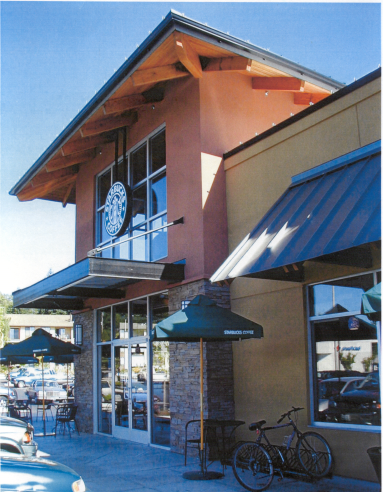18J.60.080 Building Design and Placement.
A. Non-Residential Design within Moderate Density Single Family (MSF), Single Family (SF), and Residential Resource (RR) Zones.
1. Design Objective – Building Design. MSF, SF, and RR-zoned areas are primarily residential in nature. Non-residential buildings located within these areas should be designed to incorporate features such as facades, roof forms, porches, window treatments, and architectural detailing that exemplifies surrounding residential architecture.
a. Building Entry Standards.
(1) Entrances shall incorporate one of the following building elements:
(a) Dormers;
(b) Porches; or
(c) Porticos. (See Figure 18J.60.080-1)
FIGURE 18J.60.080-1 – Building Entry Details
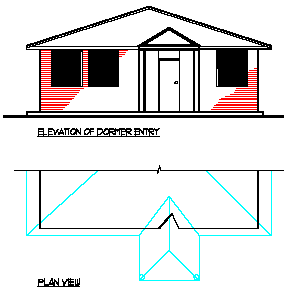
b. Building Roof Standards.
(1) Buildings shall be designed with gable, gambrel, or hip roof forms. (See Figure 18J.60.080-2.)
(2) Roof planes shall be varied by using gable ends and/or dormers.
(3) The use of flat, mansard, dome, or butterfly roof forms, is prohibited. (See Figure 18J.60.080-3.)
FIGURE 18J.60.080-2 – Acceptable Roof Forms
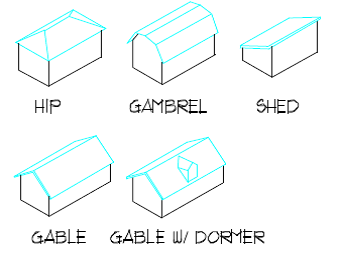
FIGURE 18J.60.080-3 – Unacceptable Roof Forms
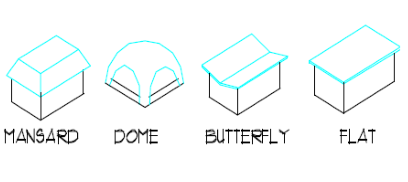
c. Architectural Detailing Standards. At least one element from each of the following categories shall be included in the design of all new buildings and accessory structures: (See Figures 18J.60.080-4 through -6)
(1) Cornice details;
(2) Trim details;
(3) Timber details; or
(4) Knee bracing.
FIGURE 18J.60.080-4 – Trim Detail
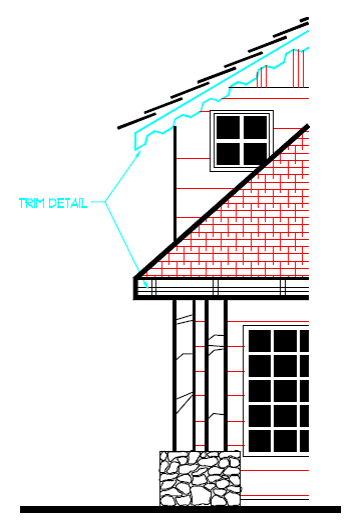
FIGURE 18J.60.080-5 – Timber Detailing
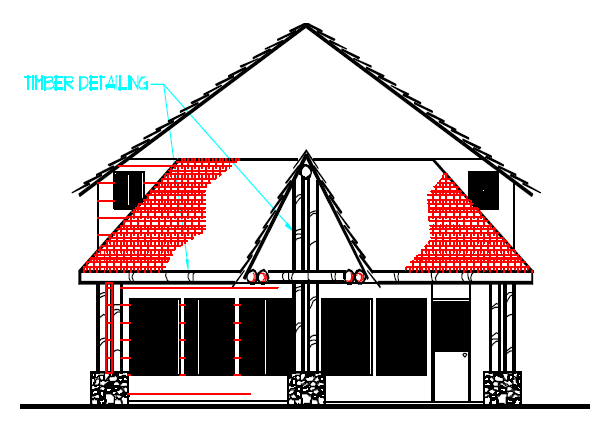
FIGURE 18J.60.080-6 – Knee Bracing
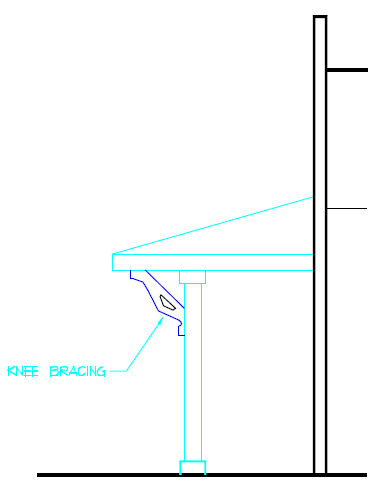
d. Window Standards. (See Figure 18J.60.080-7.)
(1) Window patterns shall be characterized by vertical proportions with horizontally-oriented rectangular forms prohibited. Windows should emphasize the first floor.
(2) The area of first-story windows on street front elevations shall be at least twice the area of second-story windows along the same side of the building.
(3) One of the following window treatments shall be used:
(a) Bay windows;
(b) Stained glass; or
(c) Multi-paned windows, or the appearance of multi-pained windows, in one-over-one, two-over-two, or four-over-four patterns.
(4) Windows sills shall be situated at least 2 feet above the interior finished floor.
(5) The use of reflective or mirrored windows is prohibited.
(6) Window trim shall be used.
FIGURE 18J.60.080-7 – Window Example
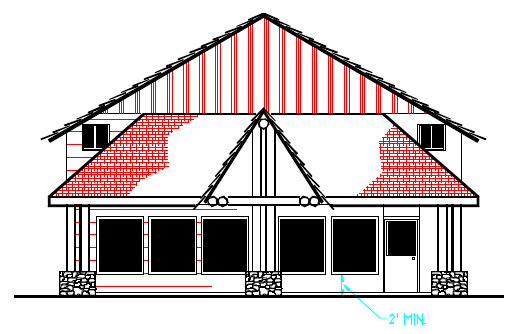
e. Guidelines.
(1) Encourage architecture that is contextual or harmonious in character to residential uses through the use of color, materials, textures, and landscaping. Development should provide focal points for neighborhoods and enhance the identity of the neighborhood.
(2) Architecture should be similar to residential structures. The use of standardized "corporate or franchise" style in the design of buildings should be avoided.
B. Design within the Employment Center (EC), Employment Corridor (ECOR) and Neighborhood Corridor (NCOR) Zones. Promote design in all building projects within the ECOR and NCOR zones and non-industrial building projects within the EC zone that provides cohesiveness, consistency, and architectural detailing without restricting architectural creativity. Promote developments that are both auto- and pedestrian-oriented and create buildings and site designs that appeal to both.
1. Design Objective – Architectural Concept. Project designs shall provide a cohesive and consistent visual identity for all buildings and accessory structures in a development while responding to functional characteristics of the project.
a. Standards.
(1) All new and remodeled buildings within a multi-building complex shall achieve a unity of design through the use of similar architectural elements, such as roof form, exterior building materials, colors, and window style.
(2) Independent storage buildings, parking structures, and other accessory structures shall match the principal building(s) in form, color, and use of materials and detailing.
(3) Project designs shall use the following materials: concrete, wood-looking materials (no wood sheeting), concrete masonry units (CMU), brick, stucco, metal siding, or stone.
(4) Metal buildings shall only be allowed as a structural system. The building faces of all metal building must be constructed of non-metal materials.
(5) Corporate styles, architectural gimmicks, and fads shall not be permitted.
(6) Neon outlining and backlit awnings shall not be permitted.
b. Guidelines.
(1) Architectural style for new construction and additions is not restricted. Rather, the evaluation of the project should be based on the quality of its design and relationship to its surroundings. The project design should be unique and reflect the desired character of the community.
(2) Tenant entrances in a multi-tenant building should be accentuated with similar or complementary design elements, such as wall surface materials, window arrangement, color treatment, awnings, and roof forms.
(3) The use of complementary architectural elements should be considered for transitions to existing buildings on adjacent sites when such buildings conform to the standards of this Chapter.
(4) Building materials used for site features, such as outdoor furniture, lighting, fences, and screen walls, should be consistent with the primary on-site structures.
2. Design Objective – Architectural Elements and Details. Architectural elements and details shall be used that tend to reduce the perceived size of a building, provide a more human scale and provide for visual and functional continuity with adjacent and neighboring commercial, office/business, civic, and industrial structures which are consistent with design standards and guidelines of this Chapter.
a. Standards.
(1) Each building visible from a public roadway shall incorporate elements based on the building's gross square footage that equal or exceed the number of points found in Table 18J.60.080-1.
(2) Buildings shall be entitled to incorporate any combination of features as provided in Table 18J.60.080-2 in order to meet or exceed the required number of points. For points relating to a building wall-related design feature, the design feature need only be provided along the wall(s) that will be visible to the public roadway in order for the point to be earned.
|
Table 18J.60.080-1. Points Required for Each Building Face Based on Building Size |
||
|---|---|---|
|
Building Size |
ECOR zone |
NCOR and EC zones |
|
Less than 10,000 sq. ft. |
2 |
3 |
|
10,000 to 19,999 sq. ft. |
3 |
4 |
|
20,000 to 40,000 sq. ft. |
4 |
5 |
|
Greater than 40,000 sq. ft. |
4 |
6 |
|
Table 18J.60.080-2. Relating Design and Scale of Building Elements to the Building's Overall Form and Massing |
||
|---|---|---|
|
Element |
Points |
|
|
a. Horizontal shifts for walls > 80 feet (> 100 feet for industrial use types) in length (1) |
||
|
Width of shift > 20 percent of wall length |
1 |
|
|
Width of shift > 30 percent of wall length |
2 |
|
|
No walls > 80 feet (> 100 feet for industrial use types) |
1 |
|
FIGURE 18J.60.080-8 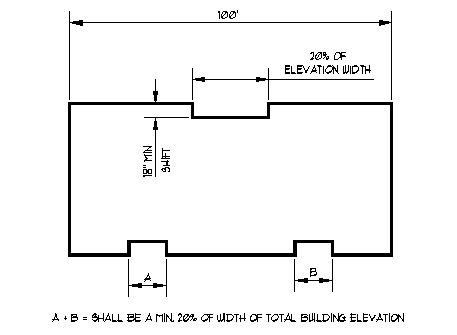
|
||
|
b. Vertical shifts of single run of ridge, cornice, or fascia > 100 feet |
||
|
Transition in height > 4 feet for buildings with height of 24 feet or greater |
||
|
(> 2 feet for industrial use types and other buildings less than 24 feet in height) |
1 |
|
|
No single runs > 80 feet (> 100 feet for industrial use types) |
1 |
|
FIGURE 18J.60.080-9 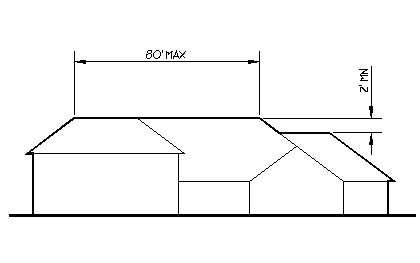
|
||
FIGURE 18J.60.080-10 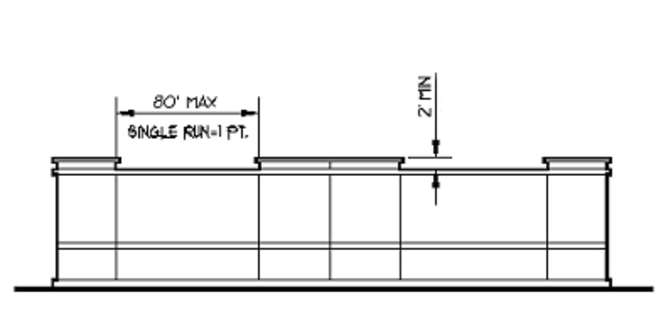
|
||
|
c. Single stand of trees within 20 feet of building (maximum 2 points) (2) |
1 |
|
FIGURE 18J.60.080-11 
|
||
FIGURE 18J.60.080-12 
|
||
FIGURE 18J.60.080-13 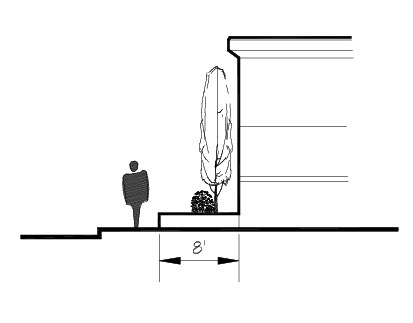
|
||
FIGURE 18J.60.080-14 
|
||
FIGURE 18J.60.080-15 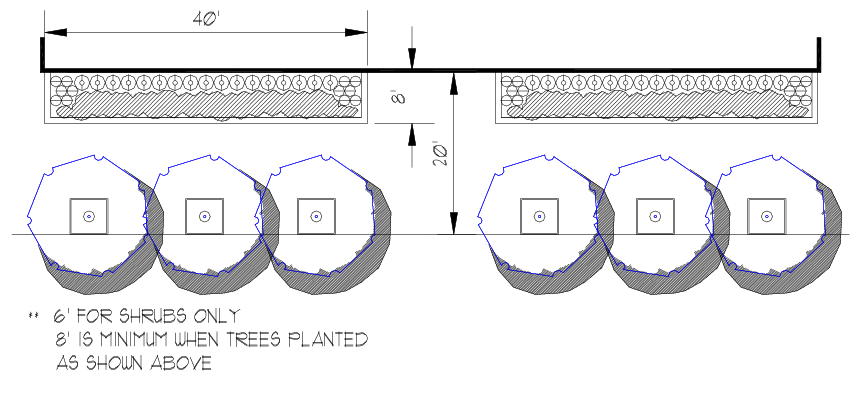
|
||
FIGURE 18J.60.080-16 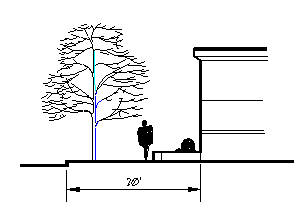
|
||
|
d. Windows |
||
|
Square footage > 30 percent of wall area visible to a public roadway |
1 |
|
|
e. Canopy or Awning (5 feet minimum depth) |
||
|
(Length) > 10 percent of wall length |
1 |
|
|
(Length) > 20 percent of wall length |
2 |
|
FIGURE 18J.60.080-17 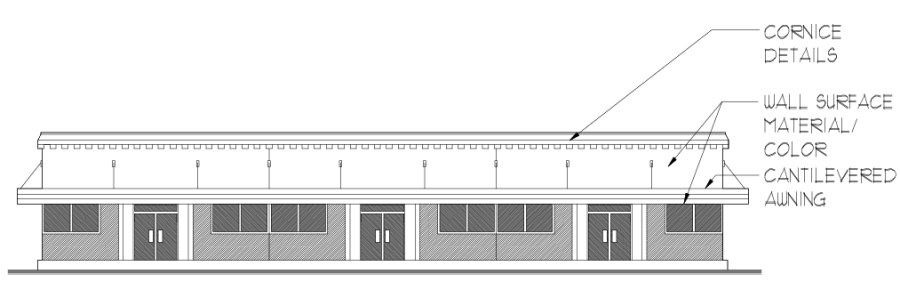
|
||
|
f. Decorative Masonry, distinguishable etchings or relief, pillars, or columns (3) |
||
|
Area covered > 10 percent of wall area |
1 |
|
|
Area covered > 30 percent of wall area |
2 |
|
FIGURE 18J.60.080-18 
|
||
|
g. Visual wall terminus or cornice required on all building sides facing a public roadway. |
||
|
Pitched roof with fascia |
FIGURE 18J.60.080-19 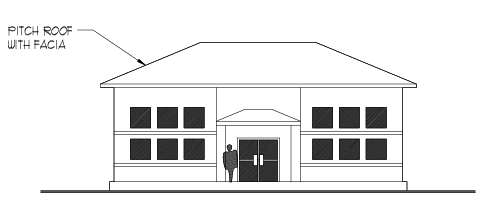
|
1 |
|
Parapet |
FIGURE 18J.60.080-20 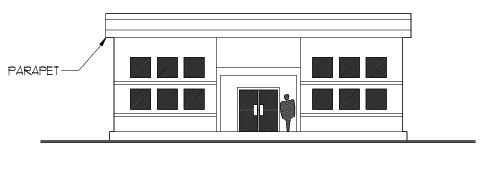
|
1 |
|
Projecting Cornice |
FIGURE 18J.60.080-21 
|
1 |
|
h. Vertical trellis with climbing vines or plant materials adjacent of walls |
||
|
Area covered > 15 percent of wall |
1 |
|
1The depth of the shift shall be equal to or greater than 18". Buildings having multiple offsets shall be designed to assure proportionality with adjacent wall planes on the same façade. Horizontal shifts, when required, shall be reflected by a shift or alteration in the roof design.
2The stand may include existing or planted trees and shall be in addition to required perimeter and internal parking lot landscaping. A stand of trees shall consist of a minimum of three trees, with a minimum caliper of 2" and minimum height of 8'. Trees may also be in separate tree wells within 20' of the building and bed.
3Solitary line etchings given a 8" wide band as credit, or multiple smaller reveals totaling 8" in width (i.e. 4 x 2" bands).
b. Guidelines. (See Figure 18J.60.080-22 for concept examples)
(1) Architectural details should be used that are consistent with the architectural character of the overall building and development. Within the Employment Service zone, overall architectural style and details should complement those used in adjacent developments where these Standards have been applied to create a consistent overall character for the community. Designs should reflect the character of the community.
(2) A visual terminus should be provided on tops of buildings in the form of cornices, parapets, or other architectural features visible from the public way.
(3) Continuous awnings that conceal important architectural elements, or conflict with the character of the building, are discouraged.
(4) Awnings should maintain the visual horizontal appearance of a street front by aligning the bottom edge thereof.
(5) Backlit awnings, designed to double as lighted signs, are discouraged.
(6) The use of durable, high quality materials that contribute to the overall appearance, ease of maintenance, and longevity of structures is encouraged.
(7) Windows should be included on upper stories to avoid blank upper walls.
(8) Building components such as windows, doors, eaves, and parapets should have architecturally appropriate proportions and relationship to one another.
FIGURE 18J.60.080-22 – Examples of Architectural Elements and Details
(Horizontal wall shifts, vertical shifts of ridge and cornice, awnings, and window treatments.)
